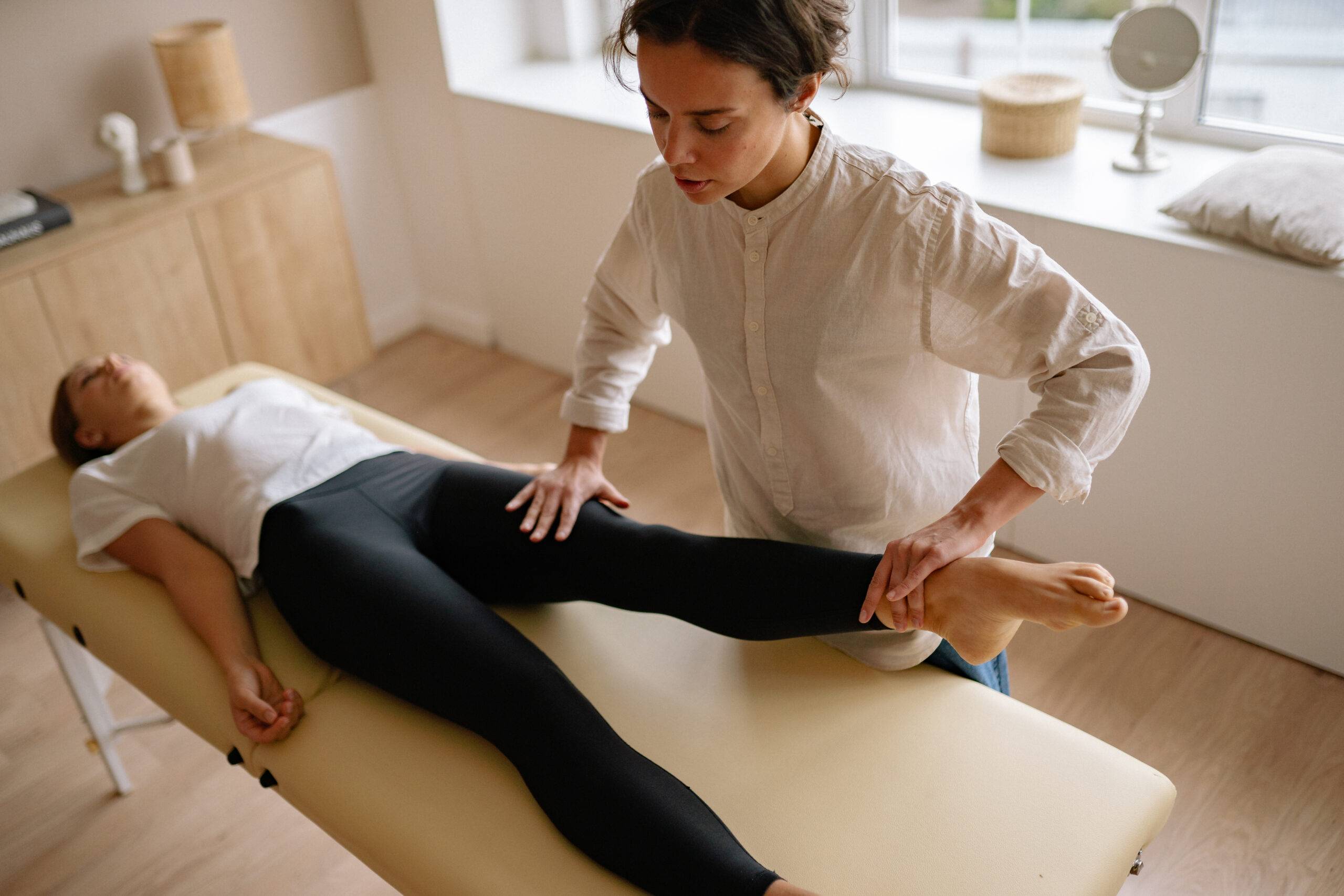Meralgia Paresthetica: Sleep Positions and Exercises for Relief
[disclosure]
Meralgia Paresthetica: Sleep Position, Exercise & Therapies for Relief
Meralgia Paresthetica is a pesky condition, but fear not! You’re about to learn the best sleeping positions, exercises, and therapies to help you find relief. So, let’s dive right in.
Understanding Meralgia Paresthetica
Before we delve into the solutions, it’s important to understand what Meralgia Paresthetica is. This condition occurs when the lateral femoral cutaneous nerve becomes compressed, resulting in tingling, numbness, and pain on the outer thigh. Common causes include obesity, tight clothing, and pregnancy. Now, let’s explore the various ways to manage Meralgia Paresthetica symptoms.
Sleeping Positions for Meralgia Paresthetica Relief
Adjusting your sleeping position can make a world of difference in managing Meralgia Paresthetica symptoms. Here are three positions to consider:
1. Side-Lying Position (Affected Side Up)
Lie on your unaffected side, with your affected leg on top. Place a pillow between your knees to keep your spine aligned and prevent nerve compression.
2. Supine Position (Back Sleeping)
Sleeping on your back allows for even weight distribution, minimizing pressure on the affected nerve. Place a pillow under your knees to maintain a neutral spine position.
3. Modified Side-Lying Position (Leg Elevated)
This position is similar to the side-lying position, but with an additional pillow or wedge to elevate the affected leg. This helps reduce nerve compression and promote blood flow.
Exercises to Alleviate Meralgia Paresthetica
Regular exercise can help relieve Meralgia Paresthetica symptoms by reducing nerve compression and improving flexibility. Try these three exercises:
1. Standing Hip Flexor Stretch
Stand up straight, with one foot in front of the other. Keep your front knee bent and your back leg straight. Push your hips forward, feeling a stretch in your back thigh. Hold for 20-30 seconds, then switch legs.
2. Seated Hamstring Stretch
Sit on the floor with your legs extended in front of you. Reach for your toes, keeping your back straight. Hold for 20-30 seconds.
3. Piriformis Stretch
Lie on your back with both knees bent. Cross your affected leg over the opposite knee, then pull the opposite knee toward your chest. Hold for 20-30 seconds, then switch legs.
Therapeutic Approaches for Meralgia Paresthetica
In addition to sleep positions and exercises, there are other therapies available to manage Meralgia Paresthetica symptoms. Let’s take a look at some options:
1. Medications
Over-the-counter pain relievers like ibuprofen, naproxen, or acetaminophen can help alleviate discomfort. In more severe cases, your doctor may prescribe stronger medications, such as opioids or anti-seizure drugs, to control pain.
2. Nerve Block Injections
A nerve block injection can provide temporary relief by blocking the pain signals from the affected nerve. This treatment usually involves a corticosteroid and a local anesthetic, and its effects can last from a few weeks to several months.
3. Transcutaneous Electrical Nerve Stimulation (TENS)
TENS therapy uses a small, portable device to deliver low-voltage electrical current through electrodes placed on the skin. This can help alleviate pain by blocking pain signals and promoting the release of endorphins.
4. Physical Therapy
A physical therapist can design a personalized treatment plan that includes stretching, strengthening, and mobility exercises to improve flexibility, reduce nerve compression, and alleviate pain.
5. Weight Loss and Lifestyle Changes
If obesity is the cause of Meralgia Paresthetica, losing weight can help alleviate symptoms. Adopting a healthy diet, exercising regularly, and avoiding tight clothing can also prevent nerve compression.
Dr. Jason Williams, DC really knows what he’s talking about with these stretches (they provided fairly rapid relief when I had painful MP)
Efficacy, Outcomes, and Duration of Treatment
The efficacy of Meralgia Paresthetica treatments varies depending on the individual and the severity of their condition. Some people may experience significant relief with conservative treatments, such as sleep position adjustments and exercises, while others may require more invasive interventions, like nerve block injections or surgery.
Expected outcomes also depend on several factors, such as the underlying cause, duration of symptoms, and the patient’s adherence to their treatment plan. In many cases, conservative treatments can provide long-term relief, especially if the cause is addressed (e.g., weight loss or avoiding tight clothing). However, some individuals may continue to experience symptoms or require ongoing treatment.
The duration of therapy varies widely, as well. Some patients may only need a few weeks of treatment, while others may require several months or even years of ongoing management. It is important to work closely with your healthcare provider to determine the most effective treatment plan for your specific situation.
Final Thoughts and Call to Action
Living with Meralgia Paresthetica can be challenging, but you can find relief by implementing these sleeping positions, exercises, and therapeutic approaches. Remember, it’s essential to consult with a healthcare professional before starting any exercise regimen or therapy. Share your thoughts, experiences, or suggestions in the comments below!
FAQs about Meralgia Paresthetica
1. What can be mistaken for Meralgia Paresthetica?
Meralgia Paresthetica can be confused with other conditions, such as hip bursitis, lumbar radiculopathy, or iliotibial band syndrome. Consult a doctor for a proper diagnosis.
2. What kind of doctor treats Meralgia Paresthetica?
Meralgia Paresthetica can be treated by a variety of specialists, including neurologists, orthopedic surgeons, and physiatrists. Your primary care physician can refer you to the appropriate specialist.
3. Is Meralgia Paresthetica dangerous?
While Meralgia Paresthetica is generally not dangerous, it can cause discomfort and impact daily life. Treatment is necessary to alleviate symptoms and prevent potential complications.
4. How to treat Meralgia Paresthetica?
Treatment for Meralgia Paresthetica may include physical therapy, pain-relief medications, weight loss, wearing loose clothing, and, in severe cases, nerve decompression surgery.
5. What’s the proper meralgia paresthetica pregnancy sleeping position?
The proper Meralgia Paresthetica pregnancy sleeping position aims to reduce pressure on the lateral femoral cutaneous nerve and accommodate the growing belly. The most recommended position is a modified side-lying position with support from pillows.
Here’s how to achieve this position:
- Lie on your unaffected side, with your affected leg on top.
- Place a pillow or wedge under your belly to provide support and maintain proper spinal alignment.
- Place another pillow between your knees to reduce pressure on your hips and lower back.
This position helps minimize nerve compression while providing support for the pregnant belly. However, always consult with your healthcare provider before making any changes to your sleeping position during pregnancy. They can offer personalized advice based on your specific circumstances and ensure the safety of both you and your baby.
6. How to sit with meralgia paresthetica?
Sitting comfortably with Meralgia Paresthetica involves minimizing pressure on the lateral femoral cutaneous nerve and maintaining good posture. Here are some tips to help you sit comfortably:
- Choose the right chair: Opt for a chair with proper lumbar support, adjustable height, and a cushioned seat. This will help maintain the natural curvature of your spine and reduce pressure on the nerve.
- Avoid crossing your legs: Crossing your legs can increase pressure on the affected nerve. Instead, keep both feet flat on the floor, with your knees bent at a 90-degree angle.
- Use a cushion or foam wedge: Placing a cushion or foam wedge on your seat can help elevate your hips, reducing compression on the nerve. This is particularly helpful if your symptoms worsen while sitting on hard surfaces.
- Change positions regularly: Sitting in one position for extended periods can aggravate Meralgia Paresthetica symptoms. Make a point of standing up, stretching, or changing positions every 30 minutes to prevent nerve compression.
- Maintain good posture: Sit up straight with your back against the chair, shoulders relaxed, and your head aligned with your spine. This helps maintain proper spinal alignment and minimizes pressure on the nerve.
By following these tips and making necessary adjustments, you can alleviate discomfort while sitting with Meralgia Paresthetica. As always, consult with your healthcare provider for personalized recommendations based on your specific situation.
Tips for Back Pain: Your Guide to Causes, Prevention, and Relief
7. Can meralgia paresthetica be cured?
Meralgia Paresthetica can often be effectively managed and, in some cases, cured. The success of treatment depends on the underlying cause of the condition and the severity of the symptoms. For many people, conservative treatments such as lifestyle changes, physical therapy, and over-the-counter pain relievers can provide significant relief and may even resolve the condition entirely.
Addressing the underlying cause is crucial for long-term success. For example, if Meralgia Paresthetica is caused by obesity or tight clothing, losing weight or wearing looser clothes may alleviate the symptoms and cure the condition.
However, in some cases, conservative treatments may not be sufficient, and more invasive treatments may be necessary. Nerve block injections, transcutaneous electrical nerve stimulation (TENS), and even nerve decompression surgery may be required for more severe or persistent cases.
It is essential to work closely with a healthcare professional to determine the most appropriate treatment plan for your specific situation. While Meralgia Paresthetica can often be cured or effectively managed, the prognosis depends on individual factors, and some people may continue to experience symptoms despite treatment.
Meditation and Pain: A Holistic Approach to Chronic Pain Management
Helpful Resources
Online Support Groups:
Meralgia Paresthetica Facebook Group
Health Unlocked Meralgia Paresthetica Community
Books:
Meralgia Paresthetica: A Comprehensive Guide by Dr. John A. Daller
Curing Meralgia Paresthetica: Pain Management for Meralgia by Dr. Godfree Roberts
Now that you’ve learned about various sleep positions, exercises, and therapies for Meralgia Paresthetica relief, it’s time to take action. Consult with your healthcare provider to discuss the best approach for your specific situation. Remember that recovery may take time, and it’s essential to be patient and diligent in following your treatment plan. I hope this information has been helpful, and I encourage you to share your thoughts, experiences, or suggestions in the comments section below. Let’s support one another in overcoming Meralgia Paresthetica and living more comfortably.












